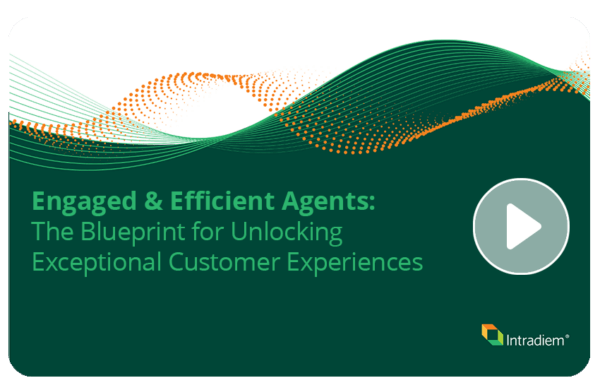
AI Driving Success for Tech-Savvy Healthcare Providers
AI Driving Success for Tech-Savvy Healthcare Providers
But healthcare remains behind other industries in agent, patient satisfaction
By Robin Gareiss
Patient experience (PX) technology, bolstered by artificial intelligence, is dramatically
transforming tech-savvy healthcare companies, whether insurance, private practices, hospitals and clinics, or managed care facilities.
Though 51.2% of healthcare providers are using AI for their patient interactions, key success metrics are below average. PX leaders are challenged to both start AI deployments and prioritize the variety of products and services available, as innovation continues at record pace. Though many options are available for PX technology, those that focus on patient care representatives (aka “agents”) are most pressing.
Healthcare companies are seeing improved patient satisfaction when agent assist is in use; in fact, it’s pretty significant at 34.9%. But it’s not as high as the all-industry average customer satisfaction improvement at 39.2%.
Investment Increases Will Drive More Success
Lack of accelerating spending on AI is a concern, as our research shows clear correlation between increased spending and increased success. Successful companies (those with higher than-average business metric improvement through the use of AI) spend 29.5% more on AI than those who are not successful.
Though healthcare providers increased AI spending by 23.8% in 2023, it wasn’t enough when compared to other industries, at 30.9%. Unfortunately, the outlook fails to deliver encouragement, with healthcare planning for 23% and 20.7% AI spending growth in 2024 and 2025, compared to 34.3% and 42.5% among all industries.
If any industry needs investment in agent-facing, AI-powered technology, it’s healthcare, given the types of interactions facing patient care representatives.
Patient Interactions Exacerbate Burnout and Attrition
Interactions with patients are typically complex because they are consultative, require adherence to strict privacy regulations, time-consuming, and often emotional. Clinicians may be dealing with life-and-death situations, while insurers may be counseling patients struggling with sizeable financial burdens.
It’s no wonder both burnout and attrition are higher in healthcare than other industries. Patient experience leaders in 62.5% of healthcare companies say they are struggling with burnout, compared to 51.5% among all industries. In healthcare, this burnout facilitates potentially dangerous outcomes, such as fallout from failure to follow privacy laws, conditions worsening from inaccurate medical advice, or drop in patient trust because of unempathetic service. Simply put, agent burnout produces a snowball effect: Tired, aggravated, and anxiety-ridden agents generate declining performance, lower patient satisfaction, lower productivity, and ultimately higher attrition.
Healthcare providers experienced a 30.2% agent attrition rate in 2023, and expect slightly worse in 2024 (32.2%)—a few percentage points higher than industry average. Taking action to ensure agents are fulfilled in their jobs will result in a trifecta: Less burnout, lower attrition rates, and improved patient satisfaction.
Healthcare’s unique requirements, however, fuel significant challenges compared to other industries. Special training, degrees, or certifications are required; experienced and degreed nurses are in demand for contact centers providing remote consultations to patients.
Considering the average hourly compensation for a registered nurse is $56 per hour, it’s imperative to implement technology that boosts their productivity, keeps them happy, and reduces turnover rates. Nearly 40% of healthcare companies say they are experiencing a shortage in patient care agents. The biggest reason, cited by 58% of companies? They can’t find the right people (among all industries, the top reason is simply company growth). Why, then, wouldn’t it be a top priority to invest in the agents on staff to ensure they don’t leave?
Healthcare companies reduce average handle time by 20.4% when they use AI to provide context and next-best-action recommendations. In a 40-hour work week, this opens eight hours of time—meaning fewer agents are needed to handle the same number of calls, resulting in cost savings.
Management and Coaching Often Lax
Because so many nurses, clinicians, insurance representatives, and others in healthcare often work from home, they lack on-site supervision and coaching for continuous improvement. AI helps tremendously for both the agent and the supervisor.
On the supervisor side, Generative AI-powered quality management can listen to every interaction and provide summary reports to supervisors, calling out areas where the nurses or representatives excelled and where they can use improvement. This provides the supervisor fodder for a productive coaching session.
In those times in between live coaching sessions, patient care representatives can get automated feedback in coaching sprints from AI. During these quick online sessions AI can provide the average patient satisfaction scores for that morning, along with pointed suggestions for improvement and encouraging words for high-performing areas.
Technologies that Provide Solutions
Given the challenges in healthcare, agent-facing, AI-powered technologies should be on the agenda of every provider in this industry.
Starting with a focus on employee health, companies can increase the chances for all types of AI to have an impact. Healthcare companies overwhelmingly said they would find value in technology (such as that offered by Intradiem) that automatically alerts supervisors to signs of agent burnout: 82.1% of healthcare companies saw value in this technology, vs. 70.9% of all industries. These figures demonstrate the value healthcare companies place on agent wellness.
With a pool of refreshed agents, it’s a lot easier for other technologies and activities to take hold, including training and coaching sprints. CX leaders say fluctuating call volumes create a challenge in finding time for this much-needed activity. As a result, coaching and training sessions—eitherdirectly with supervisors using quality management data or through Workforce Engagement tools—often get canceled. Here, too, Intradiem identifies untapped capacity in contact centers in real-time to enable coaching, training, and wellness breaks during optimal times—all of which contributes to agent happiness and patient satisfaction.
Couple that with agent assist software, which leverages various types of AI (predictive analytics, sentiment analysis, transcription, etc.) to provide agents in-the-moment advice, information, and context to deliver the best possible service. Information is delivered in the form of screen pops to guide agents on their interactions. Only 25.6% of healthcare providers used agent assist in 2023 (vs. 34.3% of all industries), but 51.3% plan to add it in 2024 (vs. 44.1% of all industries).
Going hand-in-hand with agent assist is supervisor assist, which also leverages AI to provide supervisors with context and analytics to improve agent performance and operational efficiency in the contact center. Healthcare is slightly behind on using both agent and supervisor assist for functions such as quality management and training, but ahead with schedule management and reviewing patient feedback.
By accelerating investments in technology that addresses agent productivity and wellness, healthcare providers will see improvements in patient satisfaction, agent happiness, and cost reduction.
Back to Blog








